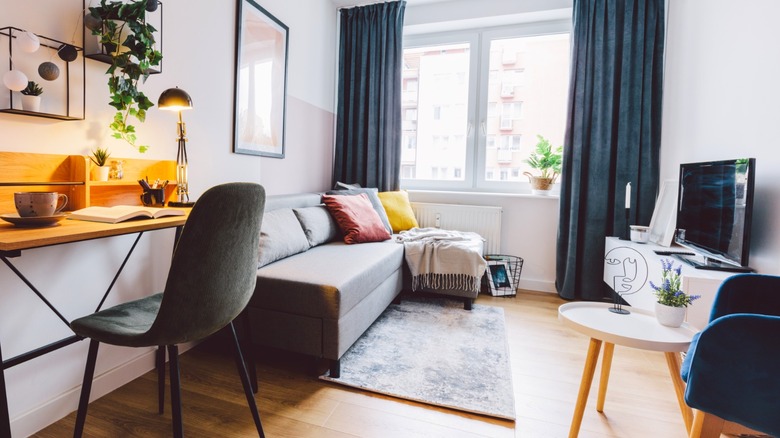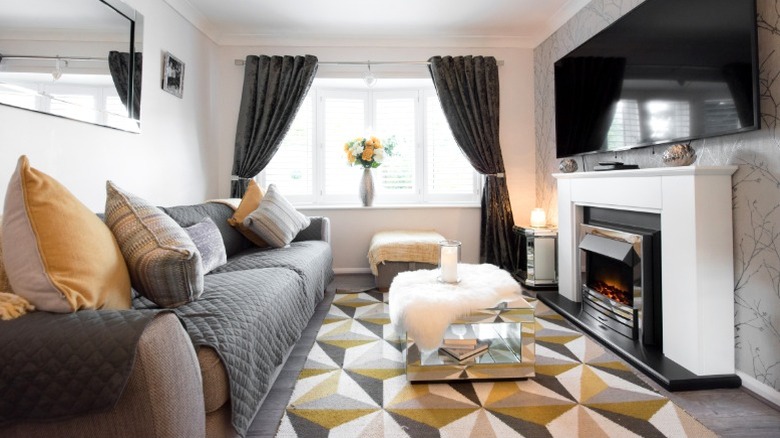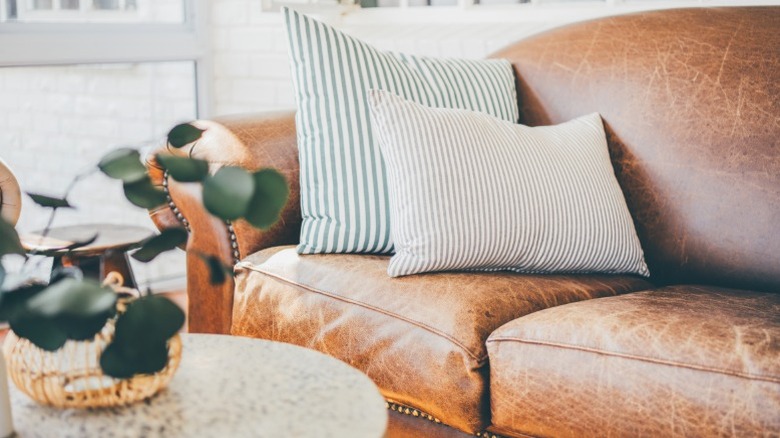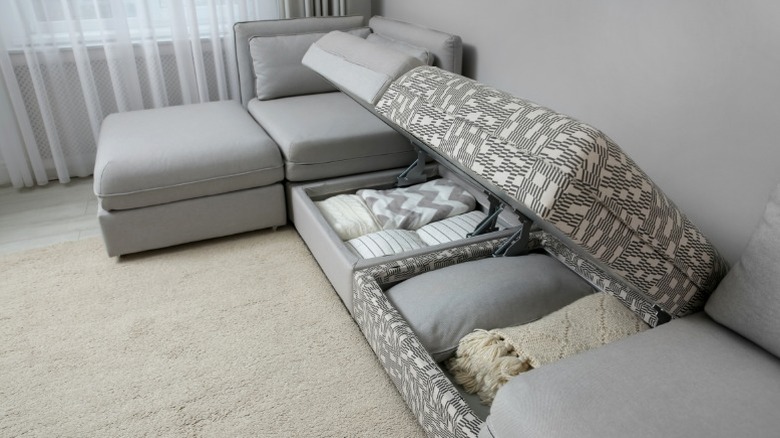Couch Mistakes That Make A Small Living Room Feel Even More Cluttered
While it's easy to blame your small living room for its cluttered look, the inconvenient truth is that it's not about the size of the space — it's how you use it. Every detail, from the smallest accessory to the grandest furniture, adds weight to the room. You can use them to open the space, but you can also misuse them and close it up. Each piece makes more of an impact the larger it gets. As you might expect, that puts a lot of the burden on the couch, which is often the main sitting furniture in the room. Screw up with this, and you're bound to make your small living room feel even more cluttered.
Broadly speaking, integrating a sofa to make the room feel more spacious depends on balance. Find the focal point in the room, whether it be a fireplace, accent wall, or piece of art, and develop the layout around that. Face the sofa towards it, positioning it on the opposite side of the room. If it makes more sense, you could also create symmetry with other furniture to create a clear visual path to it and direct the eye.
Details like texture, pattern, and color (the key to a perfectly balanced living space by some standards) play another vital role in how big the space feels. Too much variation creates visual conflict that can drag down spaces of any size. Keeping your spaces clean and minimal can help create a larger feel. If you can follow a few simple design rules and avoid common couch mistakes, you can maximize your seating and your visual space in one fell swoop.
Skipping over the sofa's scale
Getting your couch to work for your space rather than against it begins with picking the right one. Proper sofa sizing can make or break the look of the entire living room. But sofa sizing isn't necessarily straightforward. Going small makes obvious sense, of course, as you won't want anything too long or deep to overtake other design details or choke the room. A low-slung sofa could be the perfect fit to create openness for the light and air movement in the space.
Go too small with everything at an apartment-sized scale, though, and you risk losing cohesion. An excess of small pieces can add to the clutter and bring attention to a small space. Plus, it can take away from its function. After all, the furniture has to work for how you plan to use it. An undersized sofa might seem to fit the space visually, but it's a design fail if it makes you feel cramped and uncomfortable.
Don't be afraid to go big when needed. If it helps, use less furniture and smaller accents around a larger sofa to keep the room balanced and accommodating. Finding the right balance can be tricky, so if needed, fall back on simple design rules to guide your decision. Consider the 2:3 rule for sizing. Using this approach, the sofa should take up roughly two-thirds of the living room wall it's against, erring on the larger side if needed.
Poor sofa placement
It's easy to make errors working a couch into a small room when so many tricks and tips seem counter-intuitive. Just as a full-sized couch can help prevent a disoriented look in many instances, giving your sofa some breathing room can actually ease any kind of cramped look. Avoiding couch placement mistakes that will shrink your living room starts with that balanced design. Your couch can't create too much weight on one side or compete with other decor for visual space, so plan your total layout with that in mind. With light being such a friend to small areas, it's important to position your sofa so it won't block any sun that filters through windows or doors.
Ideally, you'll give your sofa at least 3 to 5 inches of space from the back wall to relax the room and improve the feng shui. Forgetting flow is a critical mistake that will instantly make you feel the clutter of a room. If you can't float the sofa, put it against the wall, but maintain space between it and surrounding features. Keep it against one wall, while leaving at least a foot of space on the other sides to keep the living room open and give the impression of more space. Give end tables a bit of space from the sides, and keep the coffee table roughly 16 to 18 inches away from the couch. Meanwhile, large furniture pieces should preferably be about 36 inches away to maintain a free walkway. When you can't do that with your small living room arrangement, try to keep open channels at least 18 inches wide.
Overlooking the visual weight of your sofa
A sofa's physical scale makes a clear impact on how cramped a room can feel, but you can help lighten the effect by addressing the visual weight the couch carries. A streamlined sofa with track arms, for instance, can maximize seating space while minimizing the sofa's footprint and making it less busy. Put the sofa on raised legs, and you'll reveal more of the floor. The extended sight lines under the furniture can let you keep all the elements you want and open the space for an uncluttered feel.
A common mistake many people make is to measure for the space and stop there, forgetting how a sofa's color and texture can influence a messy look. Leather and similarly heavy materials, for instance, can lend a more cluttered vibe than airier fabrics like linens or chenille. Ornate patterns and vivid colors may create a striking statement, but they'll be more challenging to work around when you add other elements. Light colors are often a safe choice. Creams, beiges, and other soft neutrals brighten the room and remain adaptable to changing styles and seasonal color swaps in your accents. The subdued hues will move light around and keep the attention on the room's focal point.
With that said, surrounding color schemes can affect the best choice for your sofa. A bright sofa against a dark wall may make it pop out more, leading to a more cluttered look rather than opening the room up. This is another area with flexible rules, as some may recommend bold yet cohesive colors that make you overlook the room's size. Stick with a limited color palette, and balance the sofa properly to integrate a bolder piece cleanly.
Not considering the functionality of your living room seating
In a small living room where every inch counts, less has to do more to keep clutter to a minimum. Even your sofa can bring extra function to the room, helping you save space elsewhere. Sleeper sofas are classic examples of this — you get a guest bed that hides discreetly within the footprint of the sofa when it's not in use. Modular furniture, meanwhile, creates more placement options through its multi-piece arrangement to make it easier to maintain open paths and enough seating. When you're an apartment dweller with a small living space or enjoy regular rearranging to refresh the room, you should consider a modular sofa for added versatility.
Instead of taking up floor space with chest or table storage, you can look for a sofa with built-in storage compartments. Keep extra throws, pillows, and other accessories nearby but out of the way in the compartment to help you reduce visual clutter and an overload of furniture elsewhere. You might also consider the practicality of a storage ottoman, which can similarly hold supplies. Some options have tops that flip over with a hard underside that you can use as a surface so you can eliminate the coffee table. If the ottoman doesn't have a flippable top, a decorative tray can fulfill a similar tabletop function and a stylish accent. With an oversized ottoman to match the sofa, you can also opt for a straight sofa. Pull the ottoman up to the couch to make a lounging chaise section, or push it away to open the walking space, keeping the living room free and uncluttered.




